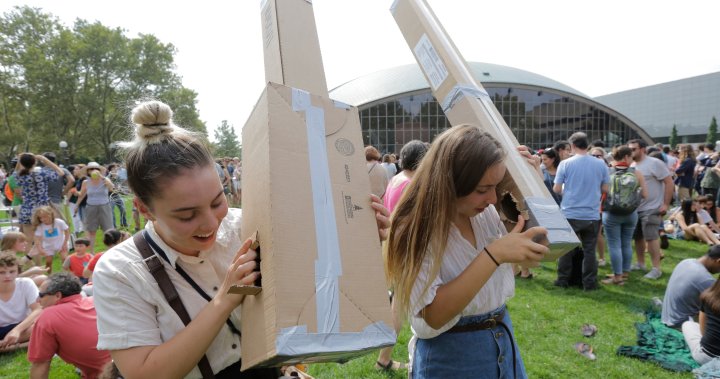Monday’s total solar eclipse is a rare event that experts describe as a once-in-a-lifetime opportunity. According to York University astrophysics professor Sarah Rugheimer, the next eclipse over Toronto and Eastern Ontario will not occur until the year 2399, a wait of 375 years. The viewing of this eclipse, however, comes with a warning as looking directly at the sun without proper protection can cause serious and even permanent damage to the eyes. If you have not yet secured ISO 12312-2 international standard glasses, there is an alternative way to observe the eclipse – using a pinhole projector, as recommended by NASA.
To make a pinhole projector, you will need a cereal or shoebox, a piece of paper, scissors, tape, aluminum foil, and a pen or other pointed object. Begin by tracing the bottom of the cereal box onto the piece of paper or the side of the shoebox. Cut along the traced line and place the smaller piece of paper at the bottom of the cereal box or the new bottom of the shoebox if turned on its side. Cut small squares out of the top of the box towards each edge. Cover one of the cut-out squares with aluminum foil and secure it with tape before piercing a small hole in it using a pen or sharp object.
During the eclipse, position yourself so that you are facing away from the sun and hold the box in front of your head, allowing you to look inside through the cut-out square. Ensure that the aluminum foil with the pinhole is facing the sun. As the sun’s rays enter through the pinhole, an image of the eclipse will be projected onto the piece of paper at the bottom of the box. This method provides a safe and indirect way to view the eclipse without risking eye damage. The projection of the eclipse image onto the paper allows for a clear and captivating observation of the celestial event.
The use of a pinhole projector is a simple and effective way to join in the excitement of the total solar eclipse without the need for specialized eclipse glasses. This DIY project can be easily assembled using common household items and following the instructions provided by NASA. By following these steps, individuals can safely witness the beauty and wonder of the eclipse while avoiding the potential harm of looking directly at the sun. Taking proper precautions to protect one’s eyes during the eclipse ensures a memorable viewing experience that is not only safe but also educational and awe-inspiring.
As the eclipse unfolds, the pinhole projector allows for the formation of a detailed image of the moon passing in front of the sun, creating a mesmerizing display of light and shadow. By using this method, viewers can appreciate the intricate dance of celestial bodies that occurs during a total solar eclipse. The unique phenomenon of the eclipse can be observed and enjoyed by individuals of all ages who follow the instructions to create and use a pinhole projector effectively. With its ability to project a clear image of the eclipse, this DIY device offers a practical and engaging way to participate in the astronomical event.
In conclusion, the total solar eclipse provides a rare opportunity to witness a spectacular celestial event that captivates audiences around the world. By utilizing a pinhole projector, individuals can safely view the eclipse and appreciate the beauty of the moon passing in front of the sun without risking eye damage. This simple and accessible method allows for a memorable and educational experience that can be shared with family and friends. As the eclipse of 2024 approaches, take the time to create your pinhole projector and join in the excitement of observing this once-in-a-lifetime event.


